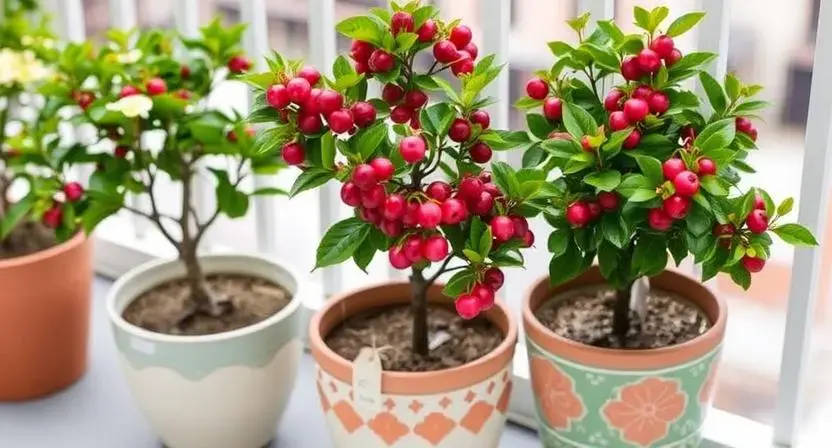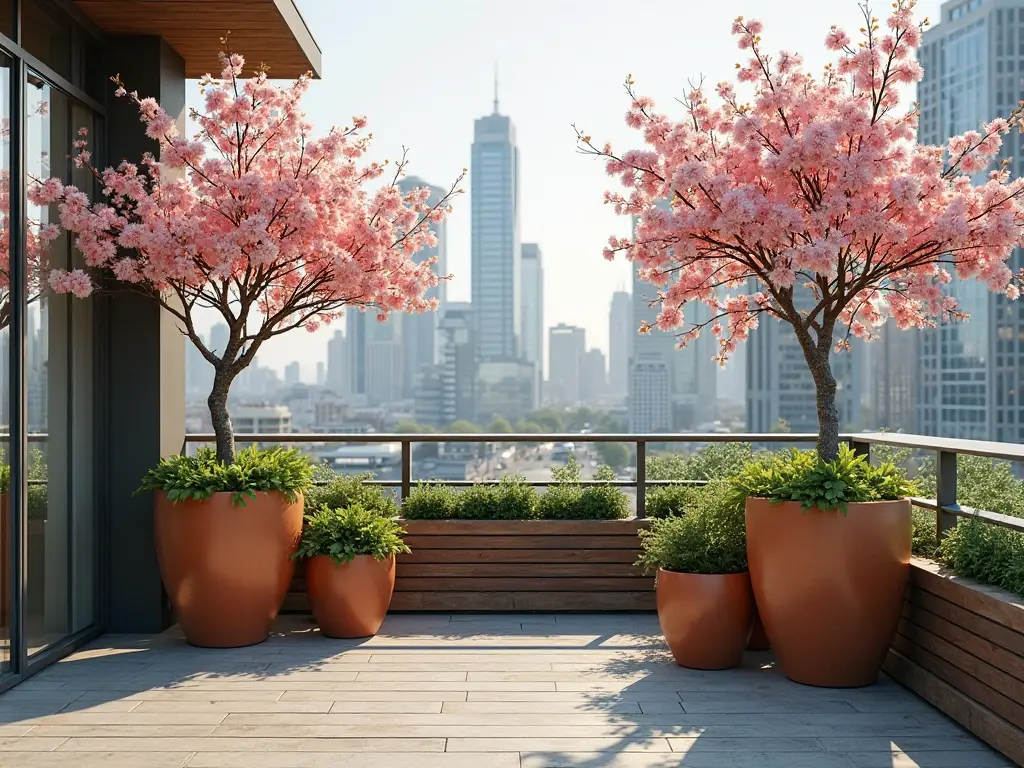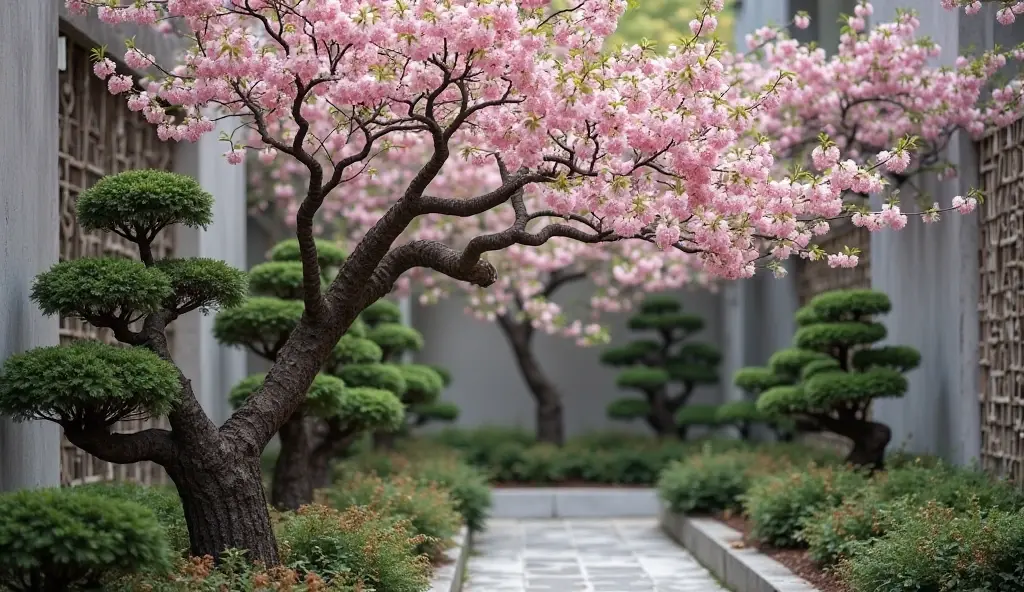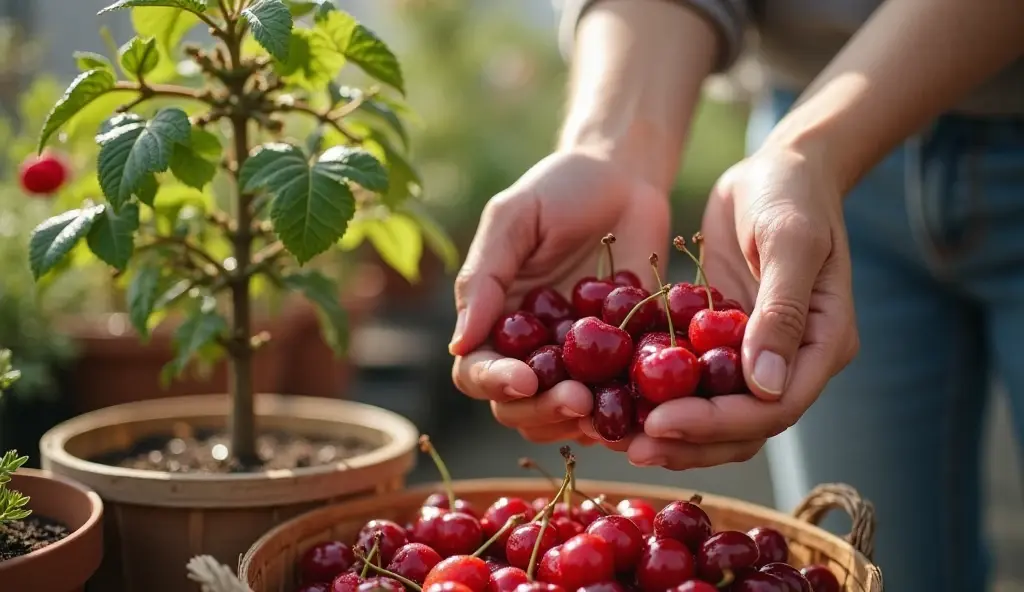Many city gardeners want to know how to grow cherry trees in small urban spaces, seeking methods to cultivate fruit and enjoy the aesthetic benefits of blossoms despite limited space. Modern techniques and dwarf varieties enable successful cultivation regardless of the urban dwelling size.
Why Growing Cherry Trees in Small Urban Spaces is Possible
Conventional wisdom suggests cherry trees require large land areas; however, modern cultivars mitigate this requirement. Due to the availability of dwarf and semi-dwarf varieties of growing Cherry trees in containers and pruning approaches, cherry trees can easily adjust to small spaces. Cultivation yields both fresh fruit and enhanced aesthetic value to the living space. Blossoms enhance the visual appeal of balconies and rooftops, while fruit crops provide a practical yield.
Urban gardeners are gradually finding their way into miniature fruit trees since they are beautiful, productive, and practical. One potted cherry tree can become a source of natural decoration, a shade-giver, and a source of fruit. Cherry blossom in the spring, juicy cherries in the summer, and the tree provides fresh fruit and aesthetic enhancement within the confines of the urban residence.
Choosing the Right Cherry Tree Variety for Urban Gardening
In considering how to grow cherry trees in small urban spaces of the city, the priority and the first one is the selection of a variety. Cherry trees do not fit well in compact lifestyles, and thus selecting a dwarf cultivar or a cultivar that fits in a container is imperative. As an illustration, some dwarf varieties that can work well within confined areas include Stella, compact Stella, North Star, or Carmine Jewel due to their size, since they can fit in smaller areas as compared to normal trees.
It also matters whether you prefer sweet cherries (Prunus avium) or sour cherries (Prunus cerasus). Sweet cherries tend to be consumed fresh, but need to be cross-pollinated, whereas sour cherries are self-pollinating and are superior for cooking and baking. In scenarios where space constraints prohibit planting two trees, a self-pollinating cultivar, such as Stella, is the recommended choice to ensure fruit set.
Table: Best Cherry Tree Varieties for Small Urban Spaces
| Variety | Type / Pollination / Height | Best Feature |
|---|---|---|
| Stella | Sweet Cherry – Self-pollinating – 10–12 ft | Tasty, small fruit, balcony-friendly |
| Compact Stella | Sweet Cherry – Self-pollinating – 8–10 ft | Compact, dwarf, container-friendly |
| North Star | Sour Cherry – Self-pollinating – 7–8 ft | Hardy, freezing-tolerant, great for pies & jams |
| Carmine Jewel | Sour Cherry – Self-pollinating – 6–7 ft | Perfect for small city spaces |
| Lapins | Sweet Cherry – Self-pollinating – 10–15 ft | Large fruits & many flowers |
Urban gardening by itself can be accomplished with just the right cherry tree. In addition, the selection of the appropriate cultivar is a critical prerequisite for successful small-space cherry tree cultivation.

Selecting the Best Containers for Cherry Trees
Comprehending container gardening is another significant step towards learning the methods of how to grow cherry trees in small urban spaces. Urban environments often lack suitable native soil; therefore, containers are essential. The container must be sized adequately to support root growth, while remaining proportionate to the available balcony or rooftop space.
This recommendation typically suggests a container with a minimum of 2025 gallons in case of the dwarf cherry trees. It must possess good drainage holes since the plant may die out fast due to waterlogging. Such materials as clay, wood, or high-quality plastic may all do, yet insulated pots are preferable because roots would not get subjected to sudden rises or drops in temperatures characteristic of urban settings.
Cherry tree requires a lot of sunlight, approximately 6-8 hours of sunlight a day, when positioning containers. An outdoor spot can be a sunny balcony, terrace, or corner of the rooftop. Container mobility facilitates the relocation of the plant to track optimal sunlight exposure throughout the day or season.

Soil Preparation for Urban Cherry Tree Growth
The key to the success of considering a method of how to grow cherry trees in small urban spaces is the soil. Container gardening bypasses issues of poor native urban soil by allowing for the creation of an optimized, high-quality soil medium. The cherry tree likes well-aerated loamy soil that has a pH of 6.0-7.0.
The best potting mix to use with cherry trees ought to include the following:
- 40 % nursery-grade yard soil
- 30 percent compost organic
- Drainage: 20 percent one part perlite or coarse sand to one part rhododendron mix
- 10 percent coco coir or peat moss as a moisture retainant
This mix gives the plants a balance, giving the roots moisture, which also allows the flow of air. Composting manure or leaf mold adds to the soil fertility, while mulching maintains moisture and regulates the temperature in an urban environment.

Sunlight and Temperature Requirements
The cherry trees require conditions of sunny and open locations, so one of the key factors on how to grow cherry trees in small urban spaces is the subject of exposure to light. Such trees require direct sun between 6 and 8 hours each day. Placing the container on a wheeled stand allows for easy movement to maximize sun exposure throughout the day.
The temperature requirement is that cherry trees normally have that chilling requirement in the winter (700-1200 hours, depending on the variety) to produce a larger number of blossoms and fruit. This causes them to adapt better to areas with different seasons. There are, however, low-chill strains available in warmer climates; however, urban cherry trees in cultivation can cover more areas.
The cityspeeds tend to impose microclimates, in which balconies can be stall stations, rooftops are blown, and courtyards are cooler. Knowledge of these circumstances will enable you to make the right choice of planting location for your cherry tree.
Watering and Fertilization in Small Spaces
The difficulty in learning how to grow cherry trees in small urban spaces is balancing water and fertilizer. Containers dry faster than in-ground soil; regular irrigation is required. Cherry trees require not waterlogged soil, that is, consistently moist. Deep irrigation should occur once or twice weekly, adjusted based on seasonal weather conditions.
The importance of fertilization is also involved. On entering the growing season (spring and summer), apply a balanced slow-release fertilizer that has the NPK ratio of 10-10-10. Chemicals should be avoided, but instead organic alternatives can be used (like the compost tea, seaweed extract, or worm castings), which are effective too. There should be no cases of over-fertilizing that can lead to a leafy plant over flowers and fruits.
Pruning and Training for Urban Cherry Trees
One of the things that is necessary in determining how to grow cherry trees in small urban spaces. Even the dwarf varieties have the possibility of exceeding their small space when not pruned. Stem and leaf may be pruned to check size, volume, form, and fruit propagation.
- Winter Pruning focuses on shaping the tree and removing crossing or weaker branches.
- Summer Pruning involves light thinning to enhance air circulation and light penetration.
- Container Training: Such training methods as espalier (against a wall) or cordon systems may be used to make the most of the space.
Urban cherry trees serve the dual function of providing edible fruit and enhancing the space as a trained, ornamental feature.

Pollination Considerations in Urban Settings
Pollination can be considered a significant process when it comes to understanding how to grow cherry trees in small urban spaces. Even though most gardeners in the cities grow self-pollinating varieties, such as either Stella or North Star, there are a few cherries that require cross-pollination. Fruit set can be altered by the limited availability of natural pollinators, such as bees, in cities.
In order to enhance pollination:
- In available space, cultivate two compatible varieties to facilitate cross-pollination.
- Put the tree close to growing flowers to get bees on it.
- Experiment: In cases of low pollinators, use a small brush to hand-pollinate.
Cherry trees that can self-pollinate are still the most suitable when land areas are very small in the urban environment.
Pest and Disease Management in Small Urban Spaces
Cities appear to be safer against pests; however, cherry trees can still be attacked by frequent bugs such as aphids, cherry fruit flies, or even fungi. The small scale of urban setups facilitates easier monitoring and maintenance.
It has some natural remedies, such as:
- Neem oil insect control through spraying.
- Sticky traps for the fruit flies.
- Good pest control, like crop rotation, is important if you plant more than one type of fruit in containers.
- Use of cut fallen leaves and fruits in the prevention of the spread of fungus.
Periodic maintenance supports tree health and reduces reliance on chemical pest control.
Harvesting Cherries in Urban Gardens
Harvest is the culminating phase of the cultivation process. Cherries normally ripen in the late spring or earlier in the summer, depending on the variety. The fruits must be fully colored, firm, and juicy to pick. Cherries do not keep on ripening once they have been picked, hence it is very important to time.
Harvesting is typically simple and direct in the controlled environment of small urban gardens. One dwarf tree alone possibly yields 10 or 20 pounds of cherries in a season to eat, bake, or preserve in jam.

Benefits of Growing Cherry Trees in Urban Spaces
The production of fruits is not the only thing that one will learn how to grow cherry trees in small urban spaces within the city.
The advantages are as follows:
- Beauty of Aesthetics: Beautiful spring flowers liven dull city streets.
- Fresh Food: Ability to have home-grown, chemical-free cherries.
- Environmental Impact: Making the city greener and creating better air.
- Mental Health: Gardening is a recognized therapeutic activity that can mitigate the stresses associated with urban living.
- Space Efficiency: Balconies can be transformed into mini-orchards, even as small as they are.
Cherry tree cultivation represents a facet of sustainable and localized food production within urban environments.
Common Mistakes to Avoid
Lots of amateurs commit mistakes in trying to learn how to grow cherry trees in small urban spaces. Avoid such traps:
- Selecting types of large trees that do not fit in containers.
- Too much water/ too little water and resultant root issues.
- Deficiency of sunlight decreases the flowering and fruiting.
- This is due to neglecting pruning requirements, which makes the tree extend beyond the allocated area.
- The fact that pollination was not taken into account resulted in inefficient fruit set.
Addressing these potential errors in advance enhances the probability of long-term productivity and success in urban cherry cultivation.
Conclusion
Knowing how to grow cherry trees in small urban spaces increases the perspectives of people living in cities who desire nature, beauty, and fresh fruit. Even in the smallest balcony or rooftop, with the use of well-designed containers, excellent soil quality, and appropriate care methods, one can turn a balcony or rooftop into an effective cherry home using dwarf varieties. Cherry tree cultivation in small urban spaces provides a viable method for city dwellers to integrate nature and fresh fruit production into their environment. By utilizing dwarf varieties, appropriate container size, specialized soil, and focused pruning techniques, a productive miniature orchard can be established on a balcony or rooftop. This practice contributes to urban greening and offers a sustainable source of fruit through manageable container gardening methods.


